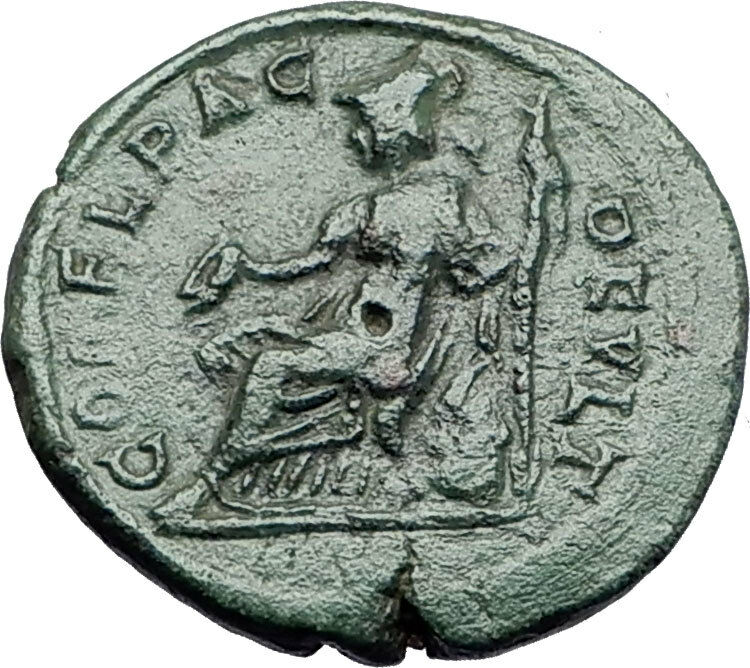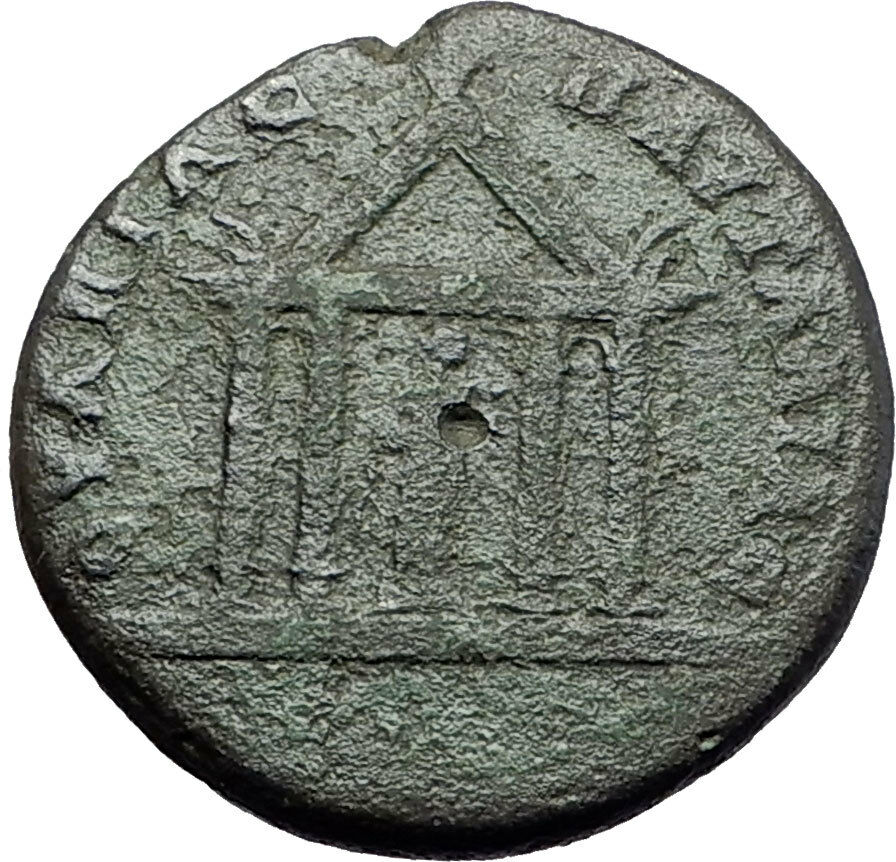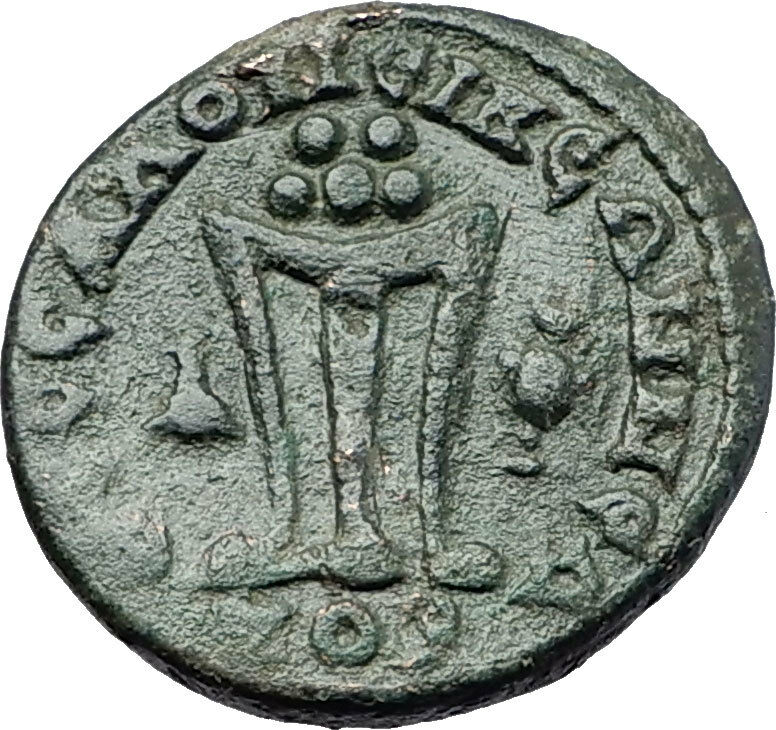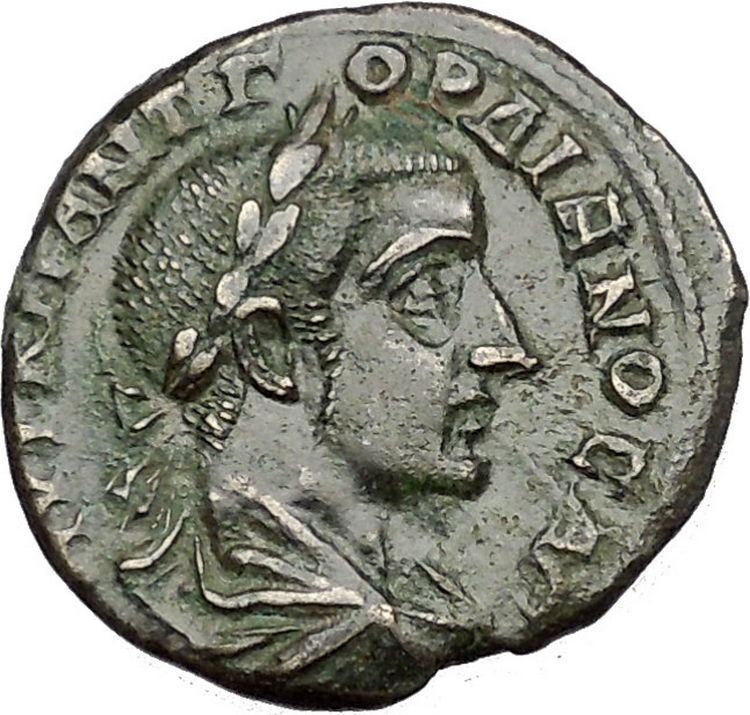|
Greek city of
Perinthus in
Thrace
Pseudo-autonomous issue under the
Romans
Bronze 16mm (3.02 grams) Struck circa 1st-2nd century A.D.
Reference: Schönert-Geiss 143
Veiled and draped bust of Demeter right, holding grain ears in raised left hand.
ΠΕΡΙΝΘΙΩΝ,
modius containing poppy between two corn-ears.
You are bidding on the exact item pictured,
provided with a Certificate of Authenticity and Lifetime Guarantee of
Authenticity.
In
Greek mythology
, Demeter (ancient
Greek Δημήτηρ, Dēmētēr)
was the goddess of the harvest, who presided over
grains
, the
fertility
of the earth, the
seasons
(personified by the
Hours
), and the
harvest
. One of her surnames is Sito (σίτος:
wheat) as the giver of food or corn. Though Demeter is often described simply as
the goddess of the harvest, she presided also over the sanctity of
marriage
, the
sacred law
, and the cycle of
life and death
. She and her daughter
Persephone
were the central figures of the
Eleusinian Mysteries
that also predated the
Olympian pantheon.
Her
Roman
cognate is
Ceres
.
Thrace (demonym Thracian
/
ənθreɪʃⁱˈ/;
Bulgarian
:
Тракия, Trakiya,
Greek
: Θράκη,
Thráki,
Turkish
:
Trakya) is a historical and geographic area in southeast
Europe
. As a geographical concept, Thrace
designates a region bounded by the
Balkan Mountains
on the north,
Rhodope Mountains
and the
Aegean Sea
on the south, and by the
Black Sea
and the
Sea of Marmara
on the east. The areas it
comprises are southeastern
Bulgaria
(Northern
Thrace), northeastern
Greece
(Western
Thrace), and the European part of
Turkey
(Eastern
Thrace). The biggest part of Thrace is part of present-day Bulgaria.
In Turkey, it is also called
Rumelia
. The name comes from the
Thracians
, an ancient
Indo-European
people inhabiting Southeastern
Europe.
The historical boundaries of Thrace have varied. Noteworthy is the fact that,
at an early date, the
ancient Greeks
employed the term “Thrace” to
refer to all of the territory which lay north of
Thessaly
inhabited by the
Thracians
,
a region which “had no definite boundaries” and to which other regions (like
Macedonia
and even
Scythia
) were added.
In one ancient Greek source, the very Earth is divided into “Asia, Libya, Europa
and Thracia”.
As the knowledge of world geography of the Greeks broadened, the term came to be
more restricted in its application: Thrace designated the lands bordered by the
Danube
on the north, by the Euxine Sea (Black
Sea) on the east, by northern
Macedonia
in the south and by the
Illyrian
lands (i.e.
Illyria
) to the west.
This largely coincided with the Thracian
Odrysian kingdom
, whose borders varied in time.
During this time, specifically after the Macedonian conquest, the region’s old
border with Macedonia was shifted from the
Struma River
to the
Mesta River
.
This usage lasted until the Roman conquest. Henceforth, (classical) Thrace
referred only to the tract of land largely covering the same extent of space as
the modern geographical region. In its early period, the
Roman province of Thrace
was of this extent,
but after the administrative reforms of the late 3rd century, Thracia’s much
reduced territory became the six small provinces which constituted the
Diocese of Thrace
. The medieval
Byzantine
theme
of
Thrace
contained only what today is
Eastern Thrace
.
The largest cities of Thrace are:
İstanbul
(European side),
Plovdiv
,
Burgas
,
Stara Zagora
,
Haskovo
,
Edirne
,
Çorlu
and
Tekirdag
.
Most of the Bulgarian and Greek population are Christians, while most of the
Turkish inhabitants of Thrace are Muslims.
Thrace in
ancient Greek mythology
Ancient Greek mythology
provides them with a
mythical ancestor, named
Thrax
, son of the war-god
Ares, who was said to reside in Thrace. The Thracians appear in
Homer
‘s
Iliad
as
Trojan allies, led by
Acamas
and
Peiros
. Later in the Iliad,
Rhesus
, another Thracian king, makes an
appearance. Cisseus
, father-in-law to the Trojan elder
Antenor
, is also given as a Thracian king.
Homeric Thrace was vaguely defined, and stretched from the River
Axios
in the west to the
Hellespont
and
Black Sea
in the east. The
Catalogue of Ships
mentions three separate
contingents from Thrace: Thracians led by Acamas and Peiros, from
Aenus
;
Cicones
led by
Euphemus
, from southern Thrace, near
Ismaros
; and from the city of
Sestus
, on the Thracian (northern) side of the
Hellespont, which formed part of the contingent led by
Asius
. Greek mythology is replete with Thracian
kings, including
Diomedes
,
Tereus
,
Lycurgus
,
Phineus
,
Tegyrius
,
Eumolpus
,
Polymnestor
,
Poltys
, and
Oeagrus
(father of
Orpheus
). In addition to the tribe that Homer
calls Thracians, ancient Thrace was home to numerous other tribes, such as the
Edones
,
Bisaltae
,
Cicones
, and
Bistones
.
Thrace is also mentioned in Ovid’s Metamorphoses in the episode of
Philomela
, Procne, and
Tereus
. Tereus, the King of Thrace, lusts after
his sister-in-law, Philomela. He kidnaps her, holds her captive, rapes her, and
cuts out her tongue. Philomela manages to get free, however. She and her sister,
Procne, plot to get revenge, by killing Itys (son of Tereus and Procne) and
serving him to his father for dinner. At the end of the myth, all three turn
into birds—Procne, a swallow; Philomela, a nightingale; and Tereus, a
hoopoe
.
History
Ancient history
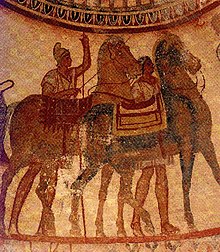
Thracian Tomb of Kazanlak
The indigenous population of Thrace was a people called the
Thracians
, divided into numerous tribal groups.
Thracian troops were known to accompany neighboring ruler
Alexander the Great
when he crossed the
Hellespont
which abuts Thrace, and took on the
Persian Empire
of the day.
The Thracians did not describe themselves as such and Thrace and
Thracians are simply the names given them by the Greeks.[5]
Divided into separate tribes, the Thracians did not manage to form a lasting
political organization until the
Odrysian state
was founded in the 4th century
BC. Like Illyrians
, Thracian tribes of the mountainous
regions fostered a locally ruled warrior tradition, while the tribes based in
the plains were purportedly more peaceable. Recently discovered funeral mounds
in Bulgaria suggest that Thracian kings did rule regions of Thrace with distinct
Thracian national identity.
During this period, a subculture of
celibate
ascetics
called the
Ctistae
lived in Thrace, where they served as
philosophers, priests and prophets.
Medieval history
By the mid 5th century, as the Roman Empire began to crumble, Thracia fell
from the authority of Rome and into the hands of Germanic tribal rulers. With
the fall of Rome, Thracia turned into a battleground territory for the better
part of the next 1,000 years. The eastern successor of the
Roman Empire
in the Balkans, the
Byzantine Empire
, retained control over Thrace
until the 8th century when the northern half of the entire region was
incorporated into the
First Bulgarian Empire
. Byzantium regained
Thrace in the late 10th century and administered it as a
theme
, until the Bulgarians regained
control of the northern half at the end of the 12th century. Throughout the 13th
century and the first half of the 14th century, the region was changing in the
hands of the Bulgarian and the Byzantine Empire(excl. Constantinopole). In 1265
the area suffered a Mongol raid from the
Golden Horde
, led by
Nogai Khan
. In 1352, the
Ottoman
Turks
conducted their first incursion into the
region subduing it completely within a matter of two decades and occupying it
for five centuries.
Modern history
With the
Congress of Berlin
in 1878, Northern Thrace was
incorporated into the semi-autonomous Ottoman province of
Eastern Rumelia
, which united with Bulgaria in
1885. The rest of Thrace was divided among Bulgaria, Greece and Turkey at the
beginning of the 20th century, following the
Balkan Wars
,
World War I
and the
Greco-Turkish War
. Today Thracian is a
strong regional identity in Greece, Turkey, Bulgaria and other neighbouring
countries.
Famous Thracians and people from Thrace
- A number of
Roman emperors
of the 3rd-5th century were
of Thraco-Roman
backgrounds (Maximinus
Thrax,
Licinius
,
Galerius
,
Aureolus
,
Leo the Thracian
, etc.). These emperors
were elevated via a military career, from the condition of common soldiers
in one of the
Roman legions
to the foremost positions of
political power
.
|







